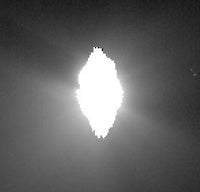Deep Impact’s spectacular collision with the comet Tempel 1 resulted
in an explosion of record traffic to the NASA Web site to see how it looked. The hyper-speed demise of the ship’s probe, as it smashed into a comet half the size of Manhattan, generated approximately 80 million page views.
“It’s off the scale,” Brian Dunbar, NASA’s Internet Services Manager, told
internetnews.com, noting the previous traffic record was 30 million
page views for the Mars landing in 2004. “Hands down, it was a record day.”
Deep Impact launched on Jan. 12. After a journey of 173 days and 268 million
miles, the ship launched an 820-pound probe at the comet. The probe hit the
comet at 1:52 a.m. on July 4. The probe was traveling at approximately
23,000 miles per hour when it collided with Tempel 1.
NASA’s digital space shutterbugs were everywhere. The Hubble Space
Telescope, the Spitzer Space Telescope and the Chandra X-ray Observatory
were all in the area of the comet to take photographs of the fiery
collision. While scientists at NASA’s Jet Propulsion Laboratory cheered and
pounded each other on the back, traffic surged at the agency’s website.
Then it surged some more. Then it continued to build on that, resulting in
approximately eight million individual viewer sessions.
“Our caching servers were hit so hard and then our origin servers were hit
hard,” Dunbar said. “We had to put in a whole new level between the caching
servers and the origin servers.”
 |
View from Deep Impact’s probe 30 minutes before it was pummeled by comet Tempel 1 (photo: nasa.gov) |
As of Tuesday afternoon, the NASA site had 39 archived pages and 500
pictures available of the Deep Impact mission.
“At the peak, we had about a billion overall impressions,” Dunbar said.
On Monday afternoon, Deep Impact Principal Investigator Dr. Michael A’Hearn
of the University of Maryland at College Park in suburban Washington, said
the probe’s final image was taken from a distance of 18.6 miles from the
comet’s surface.
“From that close distance we can resolve features on the surface that are
less than four meters (about 13 feet) across. When I signed on for this mission
I wanted to get a close-up look at a comet, but this is ridiculous? in a
great way,” he said in a statement.
The Deep Impact mission was launched to provide a view beneath the surface
of a comet. Scientists believe the material from the solar system’s
formation remains relatively unchanged and they hope the project will answer
basic questions about how the solar system formed.
According to NASA, the early images from the probe show the comet is
jet-black, approximately nine miles long and three miles wide. It is about the size
of Washington, D.C.
As for the record website traffic, Dunbar remains unsure of the real reason.
“[Traffic] has been growing since 2004,” he said. “There’s the usual growth
of the Internet and more and more people are getting broadband. But even
that doesn’t explain this.”
He paused and added, “Of course, it’s hard to beat a great explosion.”


